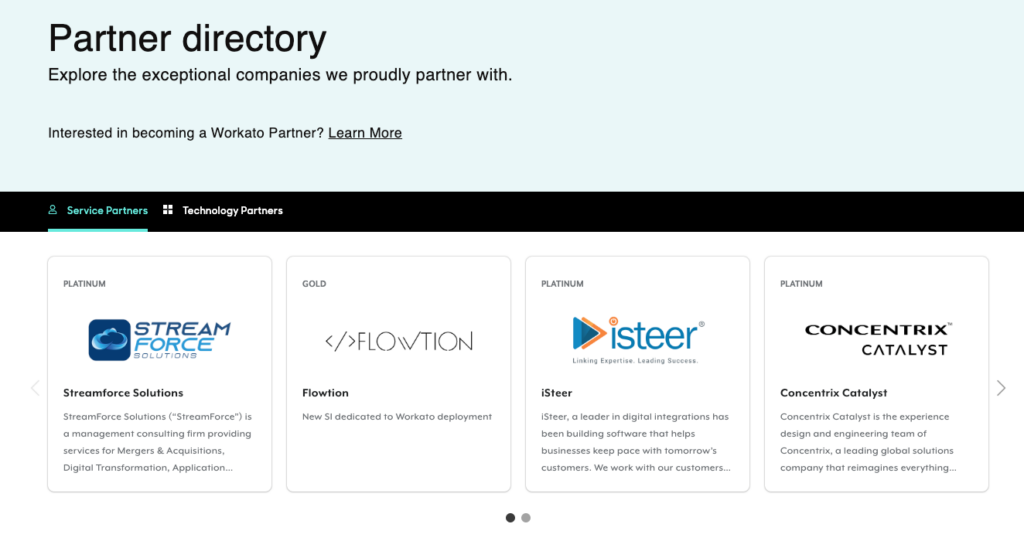Your organization will, inevitably, need to embark on time-sensitive, business-critical technology initiatives. To help your team meet the demands of these initiatives successfully and without involving many internal resources, you can engage with s systems integrator (SI).
Read on to learn how SIs operate, the benefits of working with them, and about some of the organizations that exist.
Definition of a systems integrator
A systems integrator is a partner who combines different hardware and software components or sub-systems from multiple vendors into a more capable larger system with enhanced performance ability to handle additional tasks.
A systems integrator helps businesses tackle technology projects, including implementing or replacing software, integrating applications, and building workflow automation. Given the wide range of services they offer, SIs are often staffed with enterprise architects, application admins, business analysts, and integration developers, among other roles.
Systems integration technologies emerged in the 1970s with the development of SI technologies such as Electronic Data Interchange (EDI). EDI allowed companies to transfer valuable documents seamlessly. The wave of systems integration gained momentum in the 1980s and grew bigger in the 1990s as large organizations started to seek systems integration services. SIs expanded their businesses and formed the Control Systems Integrators Association (CSIA) in 1994.
Systems integrators play a crucial role in managing and optimizing on-premises IT systems. They connect on-premises servers, databases, and applications, enabling them to share data. An enterprise application integration (EAI), for example, interconnects a company’s applications, databases, and services, enabling real-time information exchange.
Also, they help companies using legacy applications hosted on-premises leverage the strengths of such systems. They modernize the legacy apps by creating a communication channel with newer technologies hosted on the cloud.

Examples of systems integrators
SIs vary by size, specialization, and geographic presence, among other factors. Below are examples of SIs.
- Large international organizations offering a broad spectrum of services (many of which extend beyond traditional SI offerings), such as Cognizant, Deloitte, HCLTech, Accenture, and Capgemini.
- Systems integrators providing a more focused set of solutions, such as Connor Group (financial services), Dispatch Integration (HR services), and Elad CRM (GTM services).
- SIs operating within specific geographic regions and offer tailored solutions that cater to the unique needs of their local markets. Wipro (India), Atos (Europe), Dimension Data (Africa), NTT DATA Japanese, Softtek: A Latin American
- Application modernization integrators with a focus on integrating modern applications with existing, outdated systems. Rocket Software and OpenLegacy.
- Enterprise Application Integrators (EAI) such as TIBCO, Informatica, InterSystems, and WSO2.
- Electronic Data Interchange (EDI) Integrators like TrueCommerce, Cleo, DiCentral, OpenText, and SPS Commerce.
Related: Examples of IT modernization
System integrator use cases
Let’s take a closer look at how system integrators can help their clients.
Application implementation
A top reason for partnering with system integrators is that an organization needs to implement a specific application and lacks the internal expertise or bandwidth necessary to perform the work.
Once the system integrator gets looped in, here’s how they can carry out the project (at a high level):
They’d begin by gathering the business requirements for that application. This includes specific areas—such as the data fields that need to be tracked and the processes the application needs to carry out or be part of—as well as the broad business goals from using it.
After the requirements are clearly defined, the SI can begin the work of mapping out the business processes, designing the system changes and configurations, and implementing those changes into the application in a testing environment (where eventually they’re pushed to production). After the application is implemented successfully, the SI would then train the team members who need use it in order to spur fast adoption.
It’s worth noting that in many cases, business processes aren’t confined to a single application. Since multiple teams are often involved and they each work in different applications, any business process may need to work across multiple apps.
When that’s the case, the SI will need to study and understand each step to determine the best way to move data across applications, whether that’s integrating the apps via application programming interfaces (APIs), screen scraping, files, etc. They’ll also determine the 3rd-party integration tool that needs to be brought in and use it to implement the integrations.
Application migration
The system integrator can also help your organization move from one application to another successfully.
This requires the systems integrator to export data from the old system, convert it to the format the new system expects (via data type field mapping, mapping tables, etc.), and then import the data into the new system.
Related: 3 common ways to use a hybrid integration platform
The business models of systems integrator
Systems integrators typically get business in one of two ways (or through a combination of these approaches):
- Self-sourcing: where the SI works independently to win over prospects for specific projects. They can do this by engaging in traditional acquisition tactics, such as attending trade shows, using digital ads, calling prospects directly, etc.
- Working with partners: where a vendor’s sales or customer success team decides to bring in the SI, or if the vendor assists the SI in a more organic way (e.g. a prospect contacts the SI via their listing in the vendor’s partner directory)
While vendors have varying requirements for accepting SI partners, they often want an SI to have specific areas of specialization, be of a certain size (e.g. meeting an annual revenue threshold), and commit to certain sales quotas with the vendor’s product.
Once accepted, the vendor can help the SI in a number of ways (in addition to what was mentioned earlier). For example, the SI can participate in co-marketing activities, enablement trainings, and even get direct access to the vendor’s C-suite.

How has the business model of systems integrator evolved?
SIs have long integrated IT systems from different vendors and managed IT resources for organizations. However, this role has evolved and expanded to include other responsibilities. SIs can now enhance the end-user experience, ensuring that the final users of the integrated systems have a seamless, efficient, and user-friendly experience. They also manage relationships with IT vendors on behalf of their clients, including negotiating contracts.
Traditionally, SIs created custom solutions for individual clients. The new model focuses on developing scalable solutions that customers can configure and adapt through self-learning. The new business model is service-focused, with SIs offering services like remote management, maintenance contracts, and software licensing. SIs are offering value-added services that go beyond regular installations, such as integration with broader business processes and advanced analytics.
Why are systems integrators important?
Here are just a few benefits from partnering with SIs.
1. Provides the expertise needed to perform critical projects
To help explain this benefit, let’s use an example:
Say an organization needs to move from one application to another.
They may have internal resources that understand the ins and outs of the existing system, but those individuals might not know how the new system operates. As a result, leaning on them to transition to that new system could take up a lot of their time and still lead to a poor implementation.
A system integrator, on the other hand, may have performed this exact project with numerous clients, giving them a clear idea of the best practices and common pitfalls to avoid. This not only applies to the technology that needs to be implemented but also the business processes around using it (e.g. if an HRIS like Workday is being implemented, this can include employee onboarding processes with Workday).
Related: The benefits of using an iPaaS
2. Allows employees to focus on the work that they are uniquely qualified to perform
You may have a small group of employees who know how to execute certain technology projects, but they’re likely swamped with other critical tasks that only they know how to perform. In addition, the technology projects may involve a significant amount of work and have a tight deadline, making it all the more difficult for these employees to take on the projects.
SIs can help take the load off your employees’ shoulders, as they provide the additional capacity needed to carry out technology projects successfully.

3. Offers flexibility and cost savings
As opposed to hiring expensive talent full-time and using them sporadically, you can use system integrators only when they’re needed. This can help your organization lower its costs over time while not having to compromise on your technology projects’ performance. Moreover, your organization isn’t stuck with an SI. If you’re unhappy with them, you can try out another SI for your next project.
4. Addresses data quality issues
The quality of data is the foundation of systems integration. Systems integration employs data mapping techniques to combine data from diverse sources into a single location. This helps maintain data consistency and interoperability.
Data from various sources comes in various formats. Systems integrators standardize data, verify it, and enrich it for easy integration. Some have built-in data validation capabilities to confirm the completeness and accuracy of data before integrating. They use AI/ML to automate data validation, reducing the risk of integrating inaccurate data.

Need help integrating your apps and automating your workflows?
Workato, the leader in enterprise automation, works with a wide network of SIs to help you meet your digital transformation requirements.
System integrator FAQ
In case you have any more questions, we’ve addressed several more below.
What’s the difference between a VAR and a system integrator?
While value-added resellers (VARs) and SIs can overlap, the former focuses more on selling their products while the latter focuses more on selling their technology services.
How can you become a system integrator?
There are no hard and fast rules. That said, to help get your foot in the door, you can earn a bachelor’s degree in a technical field like computer science, software engineering, or physics. You can also earn certifications from specific vendors in the integration and automation space to showcase your fluency with their software.
What qualities should you look for when evaluating system integrators?
You should evaluate the clients they work with, their areas of specialization, their leadership team, and, if available, the feedback they’ve received on 3rd-party review sites.
